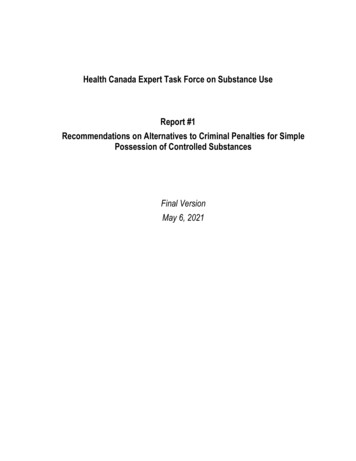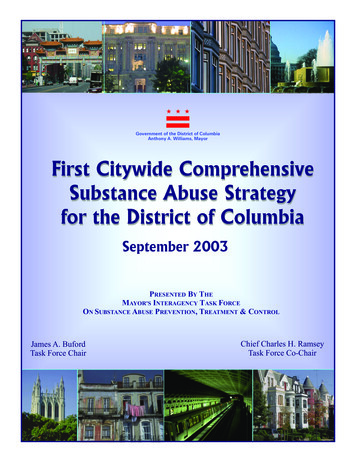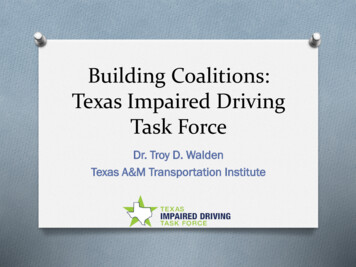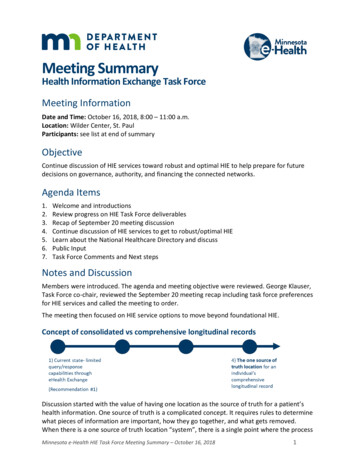
Transcription
January 30, 1998 / Vol. 47 / No. RR-2TMRecommendationsandReportsPublic Health Service Task ForceRecommendations for the Use ofAntiretroviral Drugs in Pregnant WomenInfected with HIV-1 for Maternal Healthand for Reducing Perinatal HIV-1Transmission in the United StatesU.S. DEPARTMENT OF HEALTH AND HUMAN SERVICESCenters for Disease Control and Prevention (CDC)Atlanta, Georgia 30333
The MMWR series of publications is published by the Epidemiology Program Office,Centers for Disease Control and Prevention (CDC), U.S. Department of Health and Human Services, Atlanta, GA 30333.SUGGESTED CITATIONCenters for Disease Control and Prevention. Public Health Service task force recommendations for the use of antiretroviral drugs in pregnant women infectedwith HIV-1 for maternal health and for reducing perinatal HIV-1 transmission in theUnited States. MMWR 1998;47(No. RR-2):[inclusive page numbers].Centers for Disease Control and Prevention . David Satcher, M.D., Ph.D.DirectorThe production of this report as an MMWR serial publication was coordinated in:Epidemiology Program Office. Stephen B. Thacker, M.D., M.Sc.DirectorRichard A. Goodman, M.D., M.P.H.Editor, MMWR SeriesOffice of Scientific and Health Communications (proposed)Recommendations and Reports . Suzanne M. Hewitt, M.P.A.Managing EditorRachel J. WilsonProject EditorMorie M. HigginsPeter M. JenkinsVisual Information SpecialistsUse of trade names and commercial sources is for identification only and does notimply endorsement by the U.S. Department of Health and Human Services.Copies can be purchased from Superintendent of Documents, U.S. GovernmentPrinting Office, Washington, DC 20402-9325. Telephone: (202) 512-1800.
Vol. 47 / No. RR-2MMWRiContentsIntroduction.2Background .3General Principles Regarding the Use of Antiretrovirals in Pregnancy .12Recommendations for Antiretroviral Chemoprophylaxis to ReducePerinatal HIV Transmission.14Clinical Scenarios .15Recommendations for the Monitoring of Women and Their Infants .23Future Research Needs .25References.26Single copies of this document are available from the Centers for Disease Controland Prevention, National AIDS Clearinghouse, P.O. Box 6003, Rockville, MD 20850.Telephone: (800) 458-5231.
iiMMWRJanuary 30, 1998Executive Committee and Consultants to the Public HealthService Task ForceOn May 9, 1997, the Public Health Service convened a workshop to review a) the1994 U.S. Public Health Service Task Force recommendations on use of zidovudine toreduce perinatal HIV-1 transmission; b) advances in understanding the pathogenesisof HIV-1 infection and the treatment of HIV-1 disease; and c) specific considerationsregarding use of antiretroviral drugs in pregnant HIV-1–infected women and their infants. The workshop provided updated recommendations to the Public Health Serviceon the use of antiretroviral drugs for treatment of HIV-1 infection in pregnant womenand for chemoprophylaxis to reduce perinatal HIV-1 transmission.The following persons participated in the workshop and either served as the executive committee writing group that developed the recommendations or as consultantsto the Public Health Service task force:Executive CommitteeHoward L. Minkoff, M.D. (Co-Chair)State University of New YorkHealth Science Center at BrooklynBrooklyn, NYWade Parks, M.D., Ph.D. (Co-Chair)New York University School of MedicineNew York, NYArlene D. Bardeguez, M.D.University of Medicine andDentistry of New JerseyNew Jersey Medical SchoolNewark, NJRonald Bayer, Ph.D.Columbia University Schoolof Public HealthNew York, NYCharles C. J. Carpenter, M.D.The Miriam HospitalProvidence, RIJacqueline ClementsLincoln Community Health CenterDurham, NCI. Celine Hanson, M.D.Baylor College of MedicineHouston, TXNancy Kass, Sc.D.Johns Hopkins School of Public HealthBaltimore, MDMichael K. Lindsay, M.D., M.P.H.Emory University School of MedicineAtlanta, GAKenneth McIntosh, M.D.Children’s Hospital of BostonBoston, MAHermann Mendez, M.D.State University of New York HealthScience Center at BrooklynBrooklyn, NYAngus Nicoll, M.D.PHLS Communicable DiseaseSurveillance CentreLondon, EnglandMary Jo O’Sullivan, M.D.University of Miami School of MedicineMiami, FLSallie Marie PerrymanNew York State Departmentof Health AIDS InstituteNew York, NY
Vol. 47 / No. RR-2MMWRiiiExecutive Committee (Continued)Gwendolyn Scott, M.D.University of Miami School of MedicineMiami, FLCatherine M. Wilfert, M.D.Duke University Medical CenterDurham, NCRuth Tuomala, M.D.Brigham and Women’s HospitalBoston, MACarmen Zorrilla, M.D.University of Puerto Rico Medical SchoolSan Juan, PRD. Heather Watts, M.D.University of WashingtonSeattle, WAConsultants to the Public Health Service Task ForceJean Anderson, M.D.Johns Hopkins University Schoolof MedicineBaltimore, MDPaul Krogstad, M.D.University of California,Los Angeles School of MedicineLos Angeles, CAIsaac Delke, M.D.University of FloridaHealth Science CenterJacksonville, FLLaurent Mandelbrot, M.D.Maternite Port RoyalParis, FranceDianne DonovanPositively Kids, Inc.Queensbury, NYWafaa El-Sadr, M.D., M.P.H., M.A.Harlem HospitalNew York, NYPatricia S. FlemingBethesda, MDDonna Futterman, M.D.Montefiore Medical CenterBronx, NYCheryl Healton, Dr.P.H.Columbia University Schoolof Public HealthNew York, NYSaundra D. JohnsonGay Men’s Health Crisis, Inc.New York, NYTheresa McGovern, J.D.HIV Law ProjectNew York, NYJanet Mitchell, M.D., M.P.H.Interfaith Medical CenterBrooklyn, NYEileen MonaghamPediatric CommunityConstituency GroupSpencerport, NYJoseph Perriens, M.D.UNAIDSGeneva, SwitzerlandKenneth Rich, M.D.University of Illinois at ChicagoChicago, ILPauline Thomas, M.D.New York City Department of HealthNew York, NY
ivMMWRJanuary 30, 1998Public Health Service Task ForceLynne M. Mofenson, M.D. (Chair)National Institutes of HealthBethesda, MDElaine Daniels, M.D., Ph.D.Office of HIV/AIDS PolicyWashington, DCJames McNamara, M.D.National Institutes of HealthBethesda, MDDeborah von Zinkernagel, R.N., M.S.,S.M.Office of HIV/AIDS PolicyWashington, DCMary Glenn Fowler, M.D., M.P.H.National Institutes of HealthBethesda, MDEllen Cooper, M.D.National Institutes of HealthBethesda, MDMartha Rogers, M.D.Centers for Disease Controland PreventionAtlanta, GAR.J. Simonds, M.D.Centers for Disease Controland PreventionAtlanta, GAEric Goosby, M.D.Office of HIV/AIDS PolicyWashington, DCMichael Kaiser, M.D.Health Resources andServices AdministrationRockville, MDKaren Hench, R.N.Health Resources andServices AdministrationRockville, MDSteven Gitterman, M.D., Ph.D.Food and Drug AdministrationRockville, MDDavid Lanier, M.D.Agency for Health Care Policyand ResearchRockville, MDFrances Page, R.N., M.P.H.Office on Women’s HealthWashington, DC
Vol. 47 / No. RR-2MMWRThe material in this report was prepared for publication by:Lynne M. Mofenson, M.D.Center for Research for Mothers and ChildrenNational Institute of Child Health and Human DevelopmentNational Institutes of Healthin collaboration withRobert J. Simonds, M.D.Division of HIV/AIDS Prevention—Surveillance and EpidemiologyNational Center for HIV, STD, and TB PreventionRobin R. Moseley, M.A.T.Division of AIDS, STD, and TB Laboratory ResearchNational Center for Infectious Diseasesv
viMMWRJanuary 30, 1998
Vol. 47 / No. RR-2MMWR1Public Health Service Task Force Recommendationsfor the Use of Antiretroviral Drugsin Pregnant Women Infectedwith HIV-1 for Maternal Health and for ReducingPerinatal HIV-1 Transmission in the United StatesSummaryThese recommendations update the 1994 guidelines developed by the PublicHealth Service for the use of zidovudine (ZDV) to reduce the risk for perinatalhuman immunodeficiency virus type 1 (HIV-1) transmission.* This report provides health-care providers with information for discussion with HIV-1–infectedpregnant women to enable such women to make an informed decision regarding the use of antiretroviral drugs during pregnancy. Various circumstances thatcommonly occur in clinical practice are presented as scenarios and the factorsinfluencing treatment considerations are highlighted in this report.In February 1994, the results of Pediatric AIDS Clinical Trials Group (PACTG)Protocol 076 documented that ZDV chemoprophylaxis could reduce perinatalHIV-1 transmission by nearly 70%. Epidemiologic data have since confirmed theefficacy of ZDV for reduction of perinatal transmission and have extended thisefficacy to children of women with advanced disease, low CD4 T-lymphocytecounts, and prior ZDV therapy. Additionally, substantial advances have beenmade in the understanding of the pathogenesis of HIV-1 infection and in thetreatment and monitoring of HIV-1 disease. These advances have resulted inchanges in standard antiretroviral therapy for HIV-1–infected adults. More aggressive combination drug regimens that maximally suppress viral replicationare now recommended. Although considerations associated with pregnancymay affect decisions regarding timing and choice of therapy, pregnancy is not areason to defer standard therapy. The use of antiretroviral drugs in pregnancyrequires unique considerations, including the potential need to alter dosing as aresult of physiologic changes associated with pregnancy, the potential foradverse short- or long-term effects on the fetus and newborn, and the effectiveness for reducing the risk for perinatal transmission. Data to address many ofthese considerations are not yet available. Therefore, offering antiretroviral therapy to HIV-1–infected women during pregnancy, whether primarily to treat HIV-1infection, to reduce perinatal transmission, or for both purposes, should be accompanied by a discussion of the known and unknown short- and long-termbenefits and risks of such therapy for infected women and their infants. Standard antiretroviral therapy should be discussed with and offered to HIV-1–infectedpregnant women. Additionally, to prevent perinatal transmission, ZDV chemoprophylaxis should be incorporated into the antiretroviral regimen.*Information included in these guidelines may not represent approval by the Food and DrugAdministration (FDA) or approved labeling for the particular product or indications in question.Specifically, the terms “safe” and “effective” may not be synonymous with the FDA-definedlegal standards for product approval.
2MMWRJanuary 30, 1998INTRODUCTIONIn February 1994, the Pediatric AIDS Clinical Trials Group (PACTG) Protocol 076demonstrated that a three-part regimen of zidovudine (ZDV) could reduce the risk formother-to-child HIV-1 transmission by nearly 70% (1 ). The regimen includes oral ZDVinitiated at 14–34 weeks’ gestation and continued throughout pregnancy, followed byintravenous ZDV during labor and oral administration of ZDV to the infant for 6 weeksafter delivery (Table 1). In August 1994, a Public Health Service (PHS) task force issuedrecommendations for the use of ZDV for reduction of perinatal HIV-1 transmission (2 ),and in July 1995, PHS issued recommendations for universal prenatal HIV-1 counseling and HIV-1 testing with consent for all pregnant women in the United States (3 ). Inthe 3 years since the results from PACTG 076 became available, epidemiologic studiesin the United States and France have demonstrated dramatic decreases in perinataltransmission following incorporation of the PACTG 076 ZDV regimen into generalclinical practice (4–9 ).Since 1994, advances have been made in the understanding of the pathogenesis ofHIV-1 infection and in the treatment and monitoring of HIV-1 disease. The rapidity andmagnitude of viral turnover during all stages of HIV-1 infection are greater than previously recognized; plasma virions are estimated to have a mean half-life of only6 hours (10 ). Thus, current therapeutic interventions focus on early initiation of aggressive combination antiretroviral regimens to maximally suppress viral replication,preserve immune function, and reduce the development of resistance (11 ). New, potent antiretroviral drugs that inhibit the protease enzyme of HIV-1 are now available.When a protease inhibitor is used in combination with nucleoside analogue reversetranscriptase inhibitors, plasma HIV-1 RNA levels may be reduced for prolonged periods to levels that are undetectable using current assays. Improved clinical outcomeand survival have been observed in adults receiving such regimens (12,13 ). Additionally, viral load can now be more directly quantified through assays that measure HIV-1RNA copy number; these assays have provided powerful new tools to assess diseasestage, risk for progression, and the effects of therapy. These advances have led tosubstantial changes in the standard of treatment and monitoring for HIV-1–infectedadults in the United States (14 ).TABLE 1. Pediatric AIDS Clinical Trials Group (PACTG) 076 zidovudine (ZDV) regimenTime of ZDVadministrationRegimenAntepartumOral administration of 100 mg ZDV five times daily, initiated at 14–34 weeks’gestation and continued throughout the pregnancy.IntrapartumDuring labor, intravenous administration of ZDV in a 1-hour initial dose of 2mg/kg body weight, followed by a continuous infusion of 1 mg/kg bodyweight/hour until delivery.PostpartumOral administration of ZDV to the newborn (ZDV syrup at 2 mg/kg bodyweight/dose every 6 hours) for the first 6 weeks of life, beginning at8–12 hours after birth. (Note: intravenous dosage for infants who can nottolerate oral intake is 1.5 mg/kg body weight intravenously every 6 hours.)
Vol. 47 / No. RR-2MMWR3Advances also have been made in the understanding of the pathogenesis of perinatal HIV-1 transmission. Most perinatal transmission likely occurs close to the time ofor during childbirth (15 ). Additional data that demonstrate the short-term safety of theZDV regimen are now available as a result of follow-up of infants and women enrolledin PACTG 076; however, recent data from studies of animals concerning the potentialfor transplacental carcinogenicity of ZDV affirm the need for long-term follow-up ofchildren with antiretroviral exposure in utero (16 ).These advances have important implications for maternal and fetal health. Healthcare providers considering the use of antiretrovirals in HIV-1–infected women duringpregnancy must take into account two separate but related issues: a) antiretroviraltreatment of the woman’s HIV infection and b) antiretroviral chemoprophylaxis to reduce the risk for perinatal HIV-1 transmission. The benefits of antiretroviral therapy ina pregnant woman must be weighed against the risk for adverse events to the woman,fetus, and newborn. Although ZDV chemoprophylaxis alone has substantially reducedthe risk for perinatal transmission, when considering treatment of pregnant womenwith HIV infection, antiretroviral monotherapy is now considered suboptimal for treatment; combination drug therapy is the current standard of care (14 ). This reportfocuses on antiretroviral chemoprophylaxis for the reduction of perinatal HIV transmission and a) reviews the special considerations regarding the use of antiretroviraldrugs in pregnant women, b) updates the results of PACTG 076 and related clinicaltrials and epidemiologic studies, c) discusses the use of HIV-1 RNA assays duringpregnancy, and d) provides updated recommendations on antiretroviral chemoprophylaxis for reducing perinatal transmission.These recommendations have been developed for use in the United States. Although perinatal HIV-1 transmission occurs worldwide, alternative strategies may beappropriate in other countries. The policies and practices in other countries regardingthe use of antiretroviral drugs for reduction of perinatal HIV-1 transmission may differfrom the recommendations in this report and will depend on local considerations, including availability and cost of ZDV, access to facilities for safe intravenous infusionsamong pregnant women during labor, and alternative interventions that may be beingevaluated in that area.BACKGROUNDConsiderations Regarding the Use of Antiretroviral Drugs byHIV-1–Infected Pregnant Women and Their InfantsTreatment recommendations for pregnant women infected with HIV-1 have beenbased on the belief that therapies of known benefit to women should not be withheldduring pregnancy unless they could adversely affect the mother, fetus, or infant andunless these adverse effects outweigh the benefit to the woman (17 ). Combinationantiretroviral therapy, generally consisting of two nucleoside analogue reverse transcriptase inhibitors and a protease inhibitor, is the currently recommended standardtreatment for HIV-1–infected adults who are not pregnant (14 ). Pregnancy should notpreclude the use of optimal therapeutic regimens. However, recommendationsregarding the choice of antiretroviral drugs for treatment of infected pregnant women
4MMWRJanuary 30, 1998are subject to unique considerations, including a) potential changes in dosing requirements resulting from physiologic changes associated with pregnancy and b) thepotential short- and long-term effects of the antiretroviral drug on the fetus and newborn, which may not be known for many antiretroviral drugs. The decision to use anyantiretroviral drug during pregnancy should be made by the woman after discussingthe known and unknown benefits and risks to her and her fetus with her health-careprovider.Physiologic changes that occur during pregnancy may affect the kinetics of drugabsorption, distribution, biotransformation, and elimination, thereby affecting requirements for drug dosing. During pregnancy, gastrointestinal transit time becomesprolonged; body water and fat increase throughout gestation and are accompanied byincreases in cardiac output, ventilation, and liver and renal blood flow; plasma proteinconcentrations decrease; renal sodium reabsorption increases; and changes occur inmetabolic enzyme pathways in the liver. Placental transport of drugs, compartmentalization of drugs in the embryo/fetus and placenta, biotransformation of drugs by thefetus and placenta, and elimination of drugs by the fetus also can affect drug pharmacokinetics in the pregnant woman. Additional considerations regarding drug use inpregnancy are a) the effects of the drug on the fetus and newborn, including the potential for teratogenicity, mutagenicity, or carcinogenicity and b) the pharmacokineticsand toxicity of transplacentally transferred drugs. The potential harm to the fetus frommaternal ingestion of a specific drug depends not only on the drug itself, but on thedose ingested, the gestational age at exposure, the duration of exposure, the interaction with other agents to which the fetus is exposed, and, to an unknown extent, thegenetic makeup of the mother and fetus.Information about the safety of drugs in pregnancy is derived from animal toxicitydata, anecdotal experience, registry data, and clinical trials. Minimal data are availableregarding the pharmacokinetics and safety of antiretrovirals other than ZDV duringpregnancy. In the absence of data, drug choice should be individualized and must bebased on discussion with the woman and available data from preclinical and clinicaltesting of the individual drugs.Preclinical data include in vitro and animal in vivo screening tests for carcinogenicity, clastogenicity/mutagenicity, and reproductive and teratogenic effects. However,the predictive value of such tests for adverse effects in humans is unknown. For example, of approximately 1,200 known animal teratogens, only about 30 are known to beteratogenic in humans (18 ). In addition to antiretroviral agents, many drugs commonly used to treat HIV-1–related illnesses may have positive findings on one or moreof these screening tests. For example, acyclovir is positive on some in vitro carcinogenicity and clastogenicity assays and is associated with some fetal abnormalities inrats; however, data collected on the basis of human experience from the Acyclovir inPregnancy Registry have indicated no increased risk for birth defects in infants with inutero exposure to acyclovir (19 ). Limited data exist regarding placental passage andlong-term animal carcinogenicity for the FDA-approved antiretroviral drugs (Table 2).Nucleoside Analogue Reverse Transcriptase InhibitorsOf the five currently approved nucleoside analogue antiretrovirals, only ZDV andlamivudine (3TC) pharmacokinetics have been evaluated in clinical trials of pregnanthumans. ZDV is well tolerated in pregnant women at recommended adult doses and
Vol. 47 / No. RR-2MMWR5TABLE 2. Preclinical and clinical data relevant to the use of antiretrovirals inpregnancy*AntiretroviraldrugFood and DrugAdministration (FDA)pregnancy category†Nucleoside analoguereverse transcriptaseinhibitorsZidovudine(ZDV)Placental Newborn:motherpassagedrug ratioLong-term animalcarcinogenicity studiesCIn humans0.85Zalcitabine(ddC)CIn rhesusmonkeys0.30–0.50Didanosine(ddI)BIn humans0.5Negative(no tumors, lifetimerodent study)Stavudine(d4T)CIn rhesusmonkeys0.76Not completedLamivudine(3TC)CIn humans 1.0Negative(no tumors, lifetimerodent study)Non-nucleoside neCIn humansUnknown 1.0NANot completedNot completedCIn ratsSubstantial inrats; low inrabbitsNot completedBIn ratsMid-term fetus:1.15Late-term fetus:0.15–0.64Not completedProtease inhibitorsIndinavirRitonavirPositive(rodent, noninvasivevaginal epithelialtumors)Positive(rodent, thymiclymphomas)Not completedSaquinavirBIn rats/rabbitsMinimalNot completedNelfinavirBUnknownNANot completed* Information included in this table may not represent FDA approval or approved labeling for the particularproduct or indications in question. Specifically, the terms “safe” and “effective” may not be synonymouswith the FDA-defined legal standards for product approval.†FDA pregnancy categories:A Adequate and well-controlled studies of pregnant women fail to demonstrate a risk to the fetus during thefirst trimester of pregnancy (and there is no evidence of risk during later trimesters);B Animal reproduction studies fail to demonstrate a risk to the fetus and adequate and well-controlled studies of pregnant women have not been conducted;C Safety in human pregnancy has not been determined, animal studies are either positive for fetal risk orhave not been conducted, and the drug should not be used unless the potential benefit outweighs thepotential risk to the fetus;D Positive evidence of human fetal risk based on adverse reaction data from investigational or marketingexperiences, but the potential benefits from the use of the drug in pregnant women may be acceptabledespite its potential risks;X Studies in animals or reports of adverse reactions have indicated that the risk associated with the use ofthe drug for pregnant women clearly outweighs any possible benefit.NA not applicable.
6MMWRJanuary 30, 1998in the full-term neonate at 2 mg/kg body weight administered orally every 6 hours, asobserved in PACTG 076. No data are available regarding the pharmacokinetics of 3TCadministered before 38 weeks’ gestation. However, the safety and pharmacokineticsof 3TC alone or in combination with ZDV have been evaluated after administration to20 HIV-infected pregnant women starting at 38 weeks’ gestation, continuing throughlabor, and to their infants during the first week of life (20,21 ). The drug was well tolerated in the women at the recommended adult dose of 150 mg administered orally,twice daily and had pharmacokinetics similar to those observed in nonpregnantadults. In addition, no pharmacokinetic interaction with ZDV was observed. The drugcrossed the placenta, achieving comparable serum concentrations in the woman, umbilical cord, and neonate; no short-term adverse effects were observed in theneonates. Oral clearance of 3TC in infants aged 1 week was prolonged compared withclearance in older children (0.35 L/kg/hour compared with 0.64–1.1 L/kg/hour, respectively). No data exist on 3TC pharmacokinetics in infants aged 2–6 weeks, and theexact age at which 3TC clearance begins to approximate that in older children is notknown. Based on these limited data, 3TC is being evaluated in a phase III perinatalprevention trial in Africa and in combination with ZDV and other drugs in severalphase I studies in the United States. In these studies, 3TC is administered to pregnantwomen at a dose of 150 mg of 3TC orally, twice daily and to their neonates at a doseof 2 mg/kg body weight orally, twice daily (i.e., half of the dose recommended for olderchildren).Prolonged, continuous high doses of ZDV administered to adult rodents have beenassociated with the development of noninvasive squamous epithelial vaginal tumorsin 3%–12% of females (22 ). In humans, ZDV is extensively metabolized. Most ZDVexcreted in the urine is in the form of glucuronide. In mice, however, high concentrations of unmetabolized ZDV are excreted in the urine. The vaginal tumors in mice maybe a topical effect of chronic local ZDV exposure of the vaginal epithelium, resultingfrom reflux of urine containing highly concentrated ZDV from the bladder into thevagina. Consistent with this hypothesis, when 5 mg or 20 mg ZDV/mL saline was administered intravaginally to female mice, vaginal squamous cell carcinomas wereobserved in mice receiving the highest concentration (22 ). No increase in the incidence of tumors in other organs has been observed in other studies of ZDV conductedamong adult mice and rats. High doses of zalcitabine (ddC) have been associated withthe development of thymic lymphomas in rodents. Long-term animal carcinogenicityscreening studies in which rodents have been administered ddI or 3TC have beennegative; similar studies for stavudine (d4T) have not been completed.Two studies evaluating the potential for transplacental carcinogenicity of ZDV inrodents have had differing results. In one study, two different regimens of high dailydoses of ZDV were administered to pregnant mice during the last third of the gestation period (16 ). The doses administered were near the maximum dose beyond whichlethal fetal toxicity would be observed and approximately 25 and 50 times greater thanthe daily dose administered to humans; however, the cumulative dose (on a per kgbasis) received by the pregnant mouse was similar to the cumulative dose received bya pregnant woman undergoing 6 months of ZDV therapy. In the offspring of pregnantmice exposed to ZDV at the highest dose level, an increase in lung, liver, and femalereproductive organ tumors was observed. In the second study, pregnant mice wereadministered one of several regimens of ZDV (23 ); doses were 1/12 to 1/50 the daily
Vol. 47 / No. RR-2MMWR7doses received by mice in the previous study and were intended to achieve bloodlevels approximately threefold higher than those achieved with humans in clinicalpractice. No increase in the incidence of lung or liver tumors was observed in theoffspring of these mice. Vaginal epithelial tumors were observed only in female offspring who had also received lifetime exposure to ZDV.The relevance of these animal data to humans is unknown. In January 1997, anexpert panel convened by the National Institutes of Health (NIH) reviewed these dataand concluded that the proven benefit of ZDV in reducing the risk for perinatal transmission outweighed the hypothetical concerns of transplacental carcinogenesisraised by the study of rodents. The panel also concluded that the information regarding the theoretical risk for transplacental carcinogenesis should be discussed with allHIV-infected pregnant women in the course of counseling them on the benefits andpotential risks of antiretroviral therapy during pregnancy. The panel emphasized theneed for careful, long-term follow-up of all children exposed to antiretroviral drugs inutero. Neither transplacental carcinogenicity studies for any of the other available antiretroviral drugs nor long-term or transplacental animal carcinogenicity studies ofcombinations of antiretroviral drugs have been performed.All of the nucleoside analogue antiretroviral drugs are classified as FDA PregnancyCategory C,* except for ddI, which is classified as Category B. Although all the nucleoside analogues cross the placenta in primates, in primate and placental perfusionstudies, ddI and ddC undergo substantially less placental transfer (fetal/maternal drugratios: 0.3–0.5) than do ZDV, d4T, and 3TC (fetal/maternal drug ratios: 0.7).Non-nucleoside Analogue Reverse Transcriptase InhibitorsTwo non-nucleoside reverse transcriptase inhibitors have been approved by FDA—nevirapine and delavirdine. The safety and pharmacokinetics of nevirapine wereevaluated in seven HIV-1–infected pregnant women and their infants (24 ). Nevirapinewas administered to women as a single 200-mg oral dose at the onset of labor; theinfants received a single dose of 2 mg/kg body weight when aged 2–3 days (24 ). Thedrug was well tolerated by the women and crossed the placenta; neonatal blood concentrations equivalent to those in the mother were achieved in the infants. Noshort-term adverse effects were observed in mothers or neonates. Elimination of nevirapine in pregnant women was prolonged (mean half-life: 66 hours) compared withthat in nonpregnant persons (mean half-life: 45 hours following a single dose).The half-life of nevirapine was prolonged in neonates (median
Columbia University School of Public Health New York, NY Saundra D. Johnson Gay Men's Health Crisis, Inc. New York, NY Paul Krogstad, M.D. University of California, Los Angeles School of Medicine Los Angeles, CA Laurent Mandelbrot, M.D. Maternite Port Royal Paris, France Theresa McGovern, J.D. HIV Law Project New York, NY Janet Mitchell, M.D .











